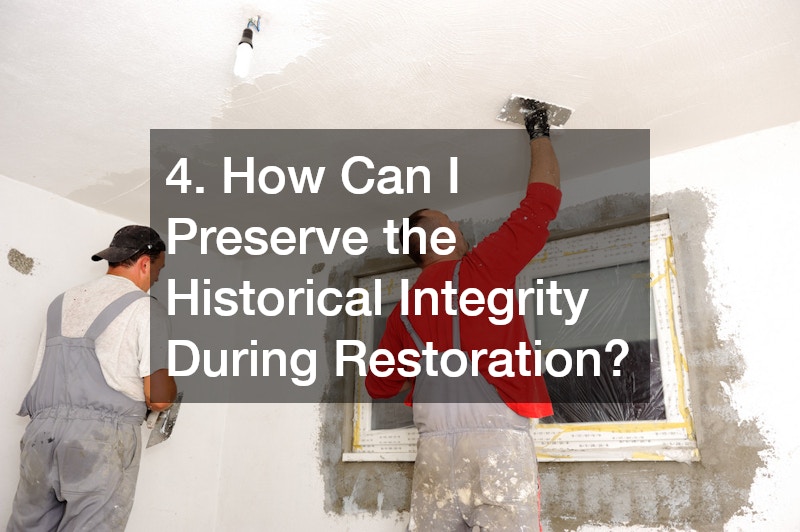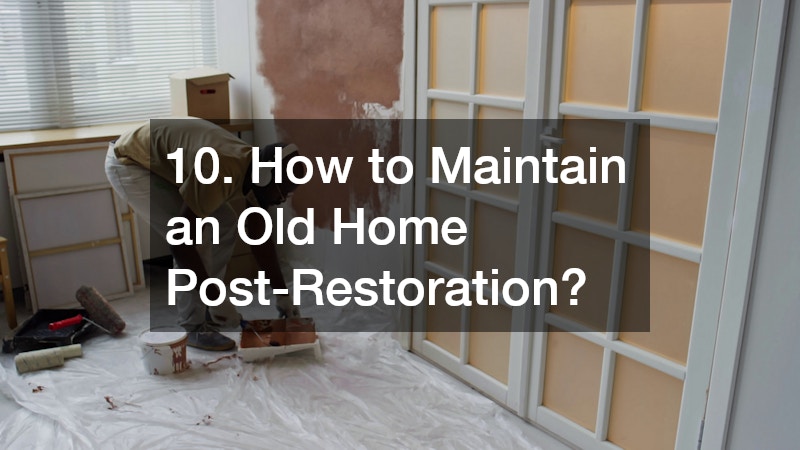Restoring old homes is more than just a construction project—it’s a journey that blends passion for history, artistry, and modern functionality. There’s something inherently satisfying about breathing new life into a house that has stood for decades, or even centuries. From preserving intricate woodwork and vintage molding to upgrading outdated systems, restoring old homes allows homeowners to honor the past while creating a comfortable, functional living environment for the future.
This guide is designed for beginners who are considering or starting a restoration project. Whether your home has a charming Victorian façade, a classic Craftsman layout, or mid-century details, the principles of thoughtful restoration remain consistent. Old homes often carry stories within their walls, reflected in original floor plans, decorative elements, and construction techniques that are rare in modern buildings. However, restoring these structures also comes with unique challenges, from outdated plumbing and electrical systems to structural wear and environmental hazards.
By understanding how to assess your home, prioritize repairs, and preserve its historical character, you can navigate the restoration process with confidence. This guide covers all the crucial steps—from initial evaluation and energy efficiency upgrades to interior design tips and long-term maintenance—to help you achieve a successful, cost-effective restoration project.
1. How Do I Assess the Condition of an Old Home?

Before diving into a restoration project, the first step is to thoroughly assess the condition of your old home. A comprehensive evaluation helps you identify both visible and hidden issues, ensuring that your efforts are focused on the areas that need the most attention.
Start with a structural inspection. Look for cracks in walls or ceilings, uneven floors, signs of water damage, or sagging rooflines. Structural deficiencies can be costly if left unaddressed, so it’s essential to bring in a professional if you notice any signs of instability.
Next, evaluate mechanical systems, including plumbing, electrical, and HVAC systems. Old heating, ventilation, and air conditioning units may be inefficient or unsafe. Hiring a reputable HVAC company to inspect and service your heating and cooling systems is crucial to ensure the home is comfortable, safe, and energy-efficient. Similarly, plumbing and wiring should be assessed by licensed professionals to prevent costly surprises during renovation.
Additionally, check for moisture issues, such as leaking pipes, roof damage, or foundation seepage, as these can lead to mold growth or structural rot. By performing a thorough assessment at the outset, you’ll establish a clear picture of the home’s condition, allowing you to prioritize repairs and develop a realistic restoration plan.
2. What Are the First Steps to Take Before Starting Restoration?
Once you understand the condition of your old home, preparation is the next crucial step. Restoration projects can quickly become chaotic without careful planning, so setting up a structured approach is essential.
Start by creating a detailed plan and budget. Identify what work needs to be done immediately, such as structural repairs, and what can be deferred to later phases. This helps prevent overspending and ensures that critical issues are addressed first.
Next, clear out the home to provide access for renovations. Old homes often accumulate debris, unused furniture, and outdated fixtures. Renting a dumpster rental is an effective solution to manage waste during the early stages of your project, keeping the workspace safe and organized. Proper disposal also allows you to assess hidden areas of the home, such as crawl spaces, basements, and attics, which may need attention.
After clearing the space, ensure that all necessary permits and inspections are obtained. Many restoration projects require approvals for electrical, plumbing, or structural changes. Securing the proper documentation upfront prevents legal issues and ensures compliance with local building codes.
By taking these preliminary steps, you establish a strong foundation for a smoother restoration process, minimizing surprises and enabling your project to progress efficiently.
3. Which Parts of the Home Should Be Prioritized?
Restoring old homes requires prioritizing work based on safety, functionality, and long-term value. Certain areas should always come first to prevent further damage and to make the home habitable.
The roof is typically the highest priority. A damaged or leaking roof can compromise the entire structure, causing water damage to ceilings, walls, and foundations. Consulting a trusted roofing company can help you assess the extent of repairs needed, whether it’s replacing shingles, reinforcing trusses, or addressing leaks.
Next, focus on plumbing and electrical systems, as outdated or faulty wiring and pipes pose safety hazards. Ensuring these systems are up to code provides peace of mind and reduces the risk of emergencies during restoration.
Other critical areas include foundation repairs, HVAC systems, and insulation. Addressing these elements early prevents secondary problems such as moisture damage, mold growth, or inefficient energy use. Prioritizing repairs logically ensures that your restoration efforts are both safe and cost-effective.
4. How Can I Preserve the Historical Integrity During Restoration?

Maintaining the historical character of your home is a key aspect of any restoration project. While modern updates improve safety and efficiency, preserving original features ensures that the home retains its unique charm.
Start by identifying original architectural elements—crown molding, woodwork, fireplaces, or flooring—and determine which features can be restored rather than replaced. When restoration isn’t possible, sourcing materials that closely match the original design is crucial.
Specialist contractors can help preserve historical integrity. For example, working with a septic pumping service ensures that plumbing updates don’t disrupt foundational or underground structures. Similarly, restorers skilled in wood, masonry, and plaster work can replicate period-accurate details.
Documenting the home’s original features before work begins can also guide restoration decisions. Photographs, sketches, and notes help ensure that renovations honor the original design. By balancing modern functionality with historical preservation, you can create a home that respects its past while serving present-day needs.
5. What Are the Common Challenges of Restoring Old Homes?
Restoration projects are rewarding but come with unique challenges. One of the most common difficulties is hidden damage—issues that are not visible during the initial inspection, such as rot, termite damage, or compromised wiring. These surprises can increase costs and extend timelines.
Painting and surface restoration is another challenge. Older homes often have layers of paint, some containing lead, which must be handled safely. Professional painting services can ensure surfaces are properly prepped, repaired, and painted without damaging the underlying materials.
Sourcing period-appropriate materials can also be time-consuming and expensive. Whether it’s vintage hardware, moldings, or flooring, finding pieces that match the home’s era may require research and patience.
Finally, balancing modern functionality with historical aesthetics can be tricky. Integrating energy-efficient systems, modern kitchens, or bathrooms while maintaining the home’s charm requires careful planning and expertise. Anticipating these challenges helps you stay prepared and ensures a smoother restoration process.
6. How Can I Make an Old Home Energy Efficient?
Restoring old homes to make them energy efficient is a key component of reducing costs and environmental impact while improving comfort. Start by assessing insulation and sealing. Gaps around windows, doors, and walls can result in significant heat loss. Upgrading insulation and using weatherstripping can make a noticeable difference.
A restoration company can help integrate energy-efficient solutions without compromising the home’s character. For example, installing energy-efficient HVAC systems, LED lighting, and high-performance windows improves functionality while respecting the original design.
Other strategies include upgrading appliances and water heaters to modern, energy-saving models. Installing programmable thermostats or solar panels, where feasible, can further reduce utility bills. By combining traditional restoration techniques with contemporary efficiency solutions, you can preserve the home’s beauty while lowering its environmental footprint.
7. What Are the Best Tips for Restoring Vintage Interiors?

Restoring vintage interiors requires careful attention to detail to maintain authenticity while improving livability. Start by evaluating original finishes, such as hardwood floors, plaster walls, and ceiling moldings. Refinishing rather than replacing these elements preserves the home’s charm.
Color schemes and textures are important. Period-appropriate paint colors, wallpapers, and fabrics help maintain the historical feel of interiors. Collaborating with a professional mold remediation company ensures that walls and surfaces are safe and free from hidden moisture or mold that could compromise both aesthetics and health.
Lighting and fixtures also contribute to vintage appeal. Restoring or replicating antique lighting, doorknobs, and cabinet hardware can enhance the overall design. Integrating modern amenities subtly—like discreet outlets or concealed wiring—allows for comfort without detracting from the home’s historical character.
8. How Do I Address Lead and Asbestos in Old Homes?
Older homes often contain hazardous materials, such as lead-based paint, asbestos insulation, or outdated wiring, which can pose serious health risks if mishandled. Lead exposure is particularly dangerous for children and pregnant women, potentially causing developmental issues and other health complications. Asbestos fibers, if inhaled, can lead to lung disease and other long-term respiratory problems. Because of these risks, it is critical to avoid DIY removal and rely on trained, certified professionals who understand safe handling and disposal procedures.
Certified contractors begin by testing and identifying hazardous materials throughout the home. Once confirmed, they employ specialized equipment and containment methods to remove or remediate these substances safely. In some cases, encapsulation—where hazardous materials are sealed rather than removed—offers a cost-effective and safe solution, preserving the home’s structural integrity while minimizing exposure.
When working with hardscaping services on exterior renovations, extra caution is necessary to avoid disturbing buried or hidden contaminants, such as asbestos siding or soil impacted by lead-based paints. Proper safety protocols, including protective gear, ventilation, and regulated disposal procedures, are essential to protect both workers and residents. By prioritizing professional handling and adhering to safety standards, homeowners can successfully restore their old homes while minimizing health risks and maintaining the property’s historical value.
9. What Are Cost-Effective Restoration Strategies?
Restoring old homes doesn’t have to break the bank. The key is to approach the project strategically, focusing first on essential repairs that ensure the home’s safety and structural integrity. Critical areas such as the foundation, roof, plumbing, and electrical systems should always take priority. Addressing these elements early prevents minor issues from escalating into expensive emergencies, such as water damage, mold growth, or structural failures, which can significantly increase overall costs.
After the major repairs are underway, homeowners can shift their attention to cosmetic upgrades. Sourcing salvaged or reclaimed materials is an effective way to maintain historical authenticity while keeping expenses low. Reclaimed wood for flooring, vintage light fixtures, repurposed bricks for chimneys or walkways, and antique hardware for cabinets add character and charm without the premium price of custom-made materials.
Working with skilled professionals, such as a pool remodeling company, masonry services, or specialty contractors for vintage details, can streamline the restoration process and reduce costly mistakes. Planning renovations in phases further improves financial management, allowing homeowners to spread out expenses and focus resources on the most important tasks at each stage. By combining careful planning, resourceful material sourcing, and professional expertise, restoring old homes can be both cost-effective and rewarding.
10. How to Maintain an Old Home Post-Restoration?

Maintenance is essential to protect your investment after completing a restoration. Regular inspections of roofs, plumbing, and foundations prevent small issues from escalating. Seasonal upkeep, such as gutter cleaning, HVAC servicing, and exterior painting, ensures the home remains in good condition.
Proper masonry services, landscape maintenance, and pest prevention also contribute to long-term durability. Installing modern monitoring systems, like moisture sensors or smart thermostats, can help detect issues early.
Engaging professional contractors for periodic maintenance ensures that structural, mechanical, and aesthetic elements are preserved. By staying proactive, homeowners can enjoy the charm of their restored old home for decades without costly setbacks.
Restoring old homes is a journey that requires careful planning, creativity, and respect for history. From initial assessment and structural repairs to energy-efficient upgrades and vintage interior restoration, each step demands thoughtful attention. While challenges like hazardous materials, hidden damage, and sourcing period-accurate materials may arise, the rewards—preserving a piece of history while creating a functional, beautiful living space—are unmatched.
By following the principles outlined in this guide, homeowners can approach restoring old homes with confidence, balancing modern comforts with historical integrity. Proper planning, prioritization, and maintenance ensure that your old home not only looks stunning but also functions efficiently for years to come. Restoring old homes is more than renovation—it’s a legacy, a chance to transform a historic structure into a livable, cherished space for future generations.
